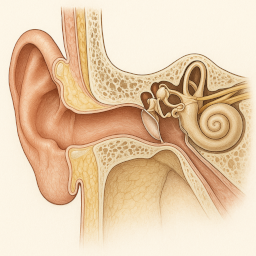What Is Ear Wax and Why Do We Need It?

Ear wax is probably not something you would discuss at lunch. When you think of ear wax, the first thing that might come to mind is probably the urge to grab a cotton swab and clean it away. But despite its reputation for being unpleasant or even “dirty,” ear wax (also called cerumen) is actually one of the body’s most helpful natural substances. So what exactly is cerumen, how is it produced, and why do we need it?
What Is Ear Wax?
A little secret!
I am going to let you in on something that is crucial for how you manage your ear wax – something that we brush over or often not even mention.
We are familiar with ear wax, a sticky, waxy substance produced by our ears. It is actually the visual finale of a great process continuously occurring within our ear canals, which removes dead skin. Without this process, our ear canals would fill with dead skin within about three months, blocking our ear canal, compromising our ear drum, and preventing us from hearing (1).
“Without this process, our ear canals would
fill with dead skin within about three months”
The process begins deep within our ear canals at the ear drum. Deep within our ear canals, a thin layer of skin covers the bony inner canal, which ends at the flexible ear drum. This skin within our ear canals constantly renews and sheds its old layer just like skin everywhere else on our body. But old skin deep within our ear canals is shed within a confined space and cannot escape like dead skin on other parts of our bodies where it falls onto our clothing or drifts away in the air.
The cleansing system in our ear canals
The skin on our bony inner canals grows outwards from the ear drum and acts as a conveyer. This skin conveyer grows outward about as quickly as our thumb nails grow. It moves refuse from deep within our ear canals towards the outside world. This skin conveyer system is our natural cleansing system for our ear canals. It is constantly pushing dust and any other foreign bodies and refuse out from deep within our ear canals.
What does ear wax have to do with the cleansing conveyer system?
So you are wondering what ear wax has to do with this cleansing conveyer system deep within our ear canal. Well, the skin conveyer system only pushes refuse about two thirds of the way outwards along the ear canal. The conveyer ends where the fleshy part of our ear canals begin. Yes, that’s right! In the outer third of our ear canals, skin covers thick soft tissue called cartilage, while deep within our canals a thin layer of skin covers hard bone. If you touch the entrance to your ear canal, you will feel soft cartilage underneath the skin – It’s cartilaginous and not bony.
Our soft, fleshy outer ear canal contains ear hairs, and glands which pump out liquids onto the outer ear canal skin. Our ear canal hairs form an incline that helps scoop the dead skin and refuse off the end of the conveyer. The liquids pump from the glands into the outer ear canal and mix with this dead skin and refuse. And voila! We now have the sticky ear wax that we are so familiar with.
But that is not the end of the story
But that is not the end of the story. The ear wax, which comes off the conveyer, continuously pushes wax outwards along our ear hairs and soft ear canal to the outside world. This pushing action begins at the end of the conveyer. As the conveyer transports more dead skin and refuse to the fleshy outer ear canal, it pushes the newly formed ear wax towards the outside of our ears. Jaw movement assists this outward journey of ear wax along our fleshy outer ear canals.
“Jaw movement assists this outward journey of ear wax along our fleshy outer ear canals.”
A major problem that can occur
Now, you may even imagine a major problem that could happen. What would happen if something interrupts flow of wax along the skin conveyer system or in the outer ear canal? If something makes a break in the flow of ear wax in our ear canal, then this will interfere with our ears’ efforts to expel ear wax – it interferes with our ears’ natural cleaning process.
What could cause a break in the natural flow of wax in our ear canals? We are sometimes tempted to view the natural flow of wax in our outer ear canal as “dirt” that needs cleaning. We go for a pack of cotton buds (Q-buds) and mop the ear wax out. Yes, it’s very satisfying work. But we have broken the natural flow of ear wax with use of cotton bud to “clean” our ears. We often push the wax deeper into our canals and then our ear wax stops flowing smoothly in an organized way along the ear canal conveyer.
Hearing aids and ear plugs also disrupt the natural flow of ear wax in our ear canals. The hearing aid dome or mold, or the ear plug creates a barrier in our outer ear canal. The skin conveyer deep within our ear canal continuously moves refuse outwards where it combines into ear wax. The conveyer continuously pushes newly formed ear wax along the outer soft ear canal until it presses up against the ear plug or hearing aid barrier. The ear wax now has nowhere to go. It pushes its way into our ear plugs and hearing aid receivers, it accumulates and, in extreme cases, it compacts into a solid mass.
Constituents of ear wax
But I still don’t know exactly what ingredients make up ear wax. As we now know, ear wax is a sticky, waxy substance produced by glands in the skin of the ear canal. Two types of glands produce fluids that combine to form ear wax in the outer fleshy part of our ear canals (1).
Sebaceous glands
The first type of gland is the sebaceous gland found beneath the skin surface and mostly associated with hairs. The sebaceous gland passively secretes a fatty substance called sebum. Incidentally, sebaceous glands are found in skin throughout our bodies and give us our naturally oily, healthy skin.
Cerumen glands
The second type of gland is the cerumen gland. You may have guessed that the cerumen gland is unique to our outer ear canals – it is not found anywhere else in our body. The cerumen gland secretes a substance, which is milky in character. The cerumen gland produces an apocrine secretion, which is a whole cell secretion that buds off from the cell. As an interesting aside, the female mammary gland also produces an apocrine secretion which, in that unique case, produces breast milk.
The outer ear canal does not contain eccrine sweat glands that are found on skin elsewhere on our body (1). Eccrine secretions from sweat glands outside the ear canal are responsible for the cooling of our body While the cerumen gland’s apocrine secretion accounts for the odour associated with healthy ear wax (2).
So, in summary, ear wax (also called cerumen) is made up of the following list of constituents:
- Sebum, an oily secretion, which is a characteristic of skin elsewhere in your body;
- Cerumen, a milky substance with peculiar odour, and unique to your ear canal ;
- Keratin, which is dead skin originating from deep within your ear canal;
- Dust and other foreign bodies that get trapped on their way into your ear.
But that’s not everything yet!
The cerumen glands secrete immunoglobulins and a range of other proteins that have antimicrobial properties. Secreted Immmunoglobulin A (IgA) often plays a role in immune function of mucous membranes. The other defensive proteins produced include lactoferrin, lysozyme, mucin, cathelicidin, and beta-defensin (1).
And we have still forgotten something…
A complex ecosystem of microorganisms inhabit our ear canals. This is natural. These microorganisms live together in peace and harmony, and often to mutual benefit, rarely creating any pathological havoc – sounds like a utopian dream.
“Sounds like a utopian dream”
And one last note
Ear wax consistency and color can vary—from light yellow and flaky to dark brown and sticky—depending on factors like age, ethnicity, diet, and personal hygiene. And that is a whole “another” story.
Summary Of Why We Need Ear Wax
1. Protection Against Infections
Ear wax has antibacterial and antifungal properties. It helps trap bacteria, dust, and other particles before they can reach the deeper parts of the ear canal or eardrum. By forming a barrier, it reduces the risk of ear infections.
2. Cleaning Agent
It might sound strange, but ear wax is actually self-cleaning. As it naturally migrates outward from the ear canal, it carries with it dirt, hair, and dead skin cells. This helps keep your ears clean without the need for manual intervention.
3. Moisturizing the Ear Canal
Ear wax prevents dryness and itching by keeping the delicate skin inside the ear canal lubricated. Without it, the skin could become flaky, irritated, or even cracked, increasing the risk of infection.
4. Barrier Against Water and Foreign Bodies
Its slightly sticky and water-resistant nature helps prevent water and insects from entering and damaging the ear canal.
Final Thoughts
Ear wax might not be glamorous, but it’s an essential part of your body’s defense system. So next time you think about getting rid of it, remember—it’s doing you a favor. Unless it’s causing a problem, it’s best to leave your ear wax alone and let your ears do their job naturally.

